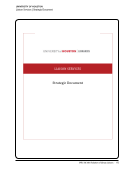SPEC Kit 349: Evolution of Library Liaisons · 173
CORNELL UNIVERSITY
Strategic Objective III.1 Formalize the Network of Library Liaisons… Appendix 4
17
• Be able to refer scholarly communication issues and requests to the appropriate service
providers
Suggested best practices for liaisons who are scholarly communication experts Include:
• Maintain regular contact with department/program to learn about researchers’ needs and
discuss scholarly communication issues
• Develop familiarity with CUL’s repositories (such as eCommons, Mann Locale, arXiv,
DigitalCommons@ILR, and SharedShelf) and service points to provide preliminary information
and referrals to faculty/researchers.
• Maintain current awareness of data management trends and issues (data management plan
requirements, sharing research data) and promote awareness of policies that pertain to
research data (funders’ requirements, IPR, privacy, confidentiality).
• Build awareness of Cornell/CUL programs that support open access and sustainable publishing,
such as the Cornell Open Access Publication (COAP) fund, and direct interested researchers to
the appropriate contacts.
• Facilitate the implementation of new policies (such as the 2007 NIH public access policy) by
informing faculty of them and related CUL support services.
• Identify needs for continuing copyright and IPR education and refer those to copyright services
as appropriate.
• Identify potential needs for digital content creation and collaborate with digital media service
providers on subsequent project development and management.
• Seek partnerships with faculty on digitization initiatives such as the ones funded by the
A&S grants.
• Promote awareness of best practices and available services for digitization and archiving
of personal holdings
Collection Development
General expectations for liaisons who are not selectors:
• Be aware of faculty and graduate student research interests and needs
• Be familiar with collections and appropriate collection development policies
• Be familiar with current publishing trends
• Be familiar with CUL’s collections fundraising initiatives
• Be aware of gift policies
• Be aware of cooperative partnerships, such as 2CUL
• Serve as a communication conduit between faculty and the library regarding their
existing and evolving needs for collection development services and tools
• Be able to refer collection development issues and requests to the appropriate
selector(s)
CORNELL UNIVERSITY
Strategic Objective III.1 Formalize the Network of Library Liaisons… Appendix 4
17
• Be able to refer scholarly communication issues and requests to the appropriate service
providers
Suggested best practices for liaisons who are scholarly communication experts Include:
• Maintain regular contact with department/program to learn about researchers’ needs and
discuss scholarly communication issues
• Develop familiarity with CUL’s repositories (such as eCommons, Mann Locale, arXiv,
DigitalCommons@ILR, and SharedShelf) and service points to provide preliminary information
and referrals to faculty/researchers.
• Maintain current awareness of data management trends and issues (data management plan
requirements, sharing research data) and promote awareness of policies that pertain to
research data (funders’ requirements, IPR, privacy, confidentiality).
• Build awareness of Cornell/CUL programs that support open access and sustainable publishing,
such as the Cornell Open Access Publication (COAP) fund, and direct interested researchers to
the appropriate contacts.
• Facilitate the implementation of new policies (such as the 2007 NIH public access policy) by
informing faculty of them and related CUL support services.
• Identify needs for continuing copyright and IPR education and refer those to copyright services
as appropriate.
• Identify potential needs for digital content creation and collaborate with digital media service
providers on subsequent project development and management.
• Seek partnerships with faculty on digitization initiatives such as the ones funded by the
A&S grants.
• Promote awareness of best practices and available services for digitization and archiving
of personal holdings
Collection Development
General expectations for liaisons who are not selectors:
• Be aware of faculty and graduate student research interests and needs
• Be familiar with collections and appropriate collection development policies
• Be familiar with current publishing trends
• Be familiar with CUL’s collections fundraising initiatives
• Be aware of gift policies
• Be aware of cooperative partnerships, such as 2CUL
• Serve as a communication conduit between faculty and the library regarding their
existing and evolving needs for collection development services and tools
• Be able to refer collection development issues and requests to the appropriate
selector(s)












































































































































































































